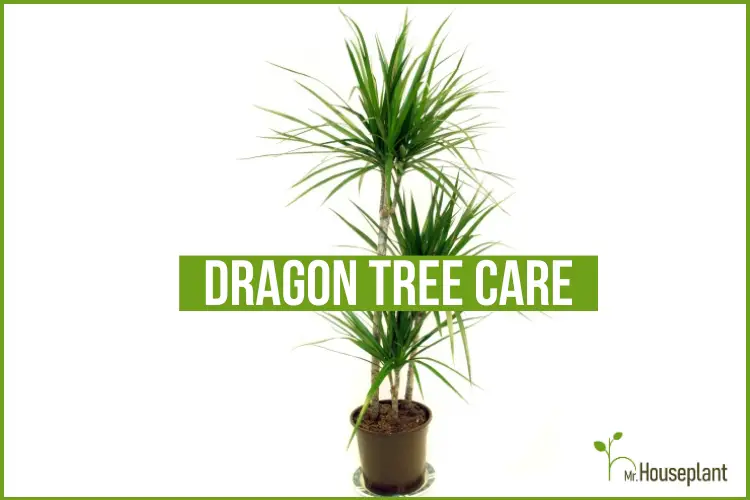
Is Dragon Tree care difficult? It doesn’t have to be if you read the article and find out everything from light, watering, temperature, and humidity to toxicity, pruning, and repotting.
| Botanical Name (Latin Name/Scientific Name): | Dracaena Marginata |
| Common Name: | Dragon tree |
| Light: | low light tolerant (50 lux – 750+ lux) |
| Watering: | once the soil is fully dry |
| Soil: | well-draining mix |
| Repotting: | once a year |
| Temperature: | 65°F to 75°F (18° to 24°C) |
| Humidity: | 25% to 50%, but it adapts well to lower humidity |
| Toxicity for Pets: | Yes (Vomiting – sometimes with blood, hypersalivation, depression, dilated pupils (cats), anorexia) |
| Toxicity for Humans: | Non-toxic |
| Propagation: | tip cuttings/stem cuttings in water or soil |
| Pruning: | Prune dead or diseased growth or when you want the plant to branch out |
Light Requirements
| Minimal amount of light: | 50 Lux (5 FC) |
| Optimal amount of light: | 750+ lux (75+ FC) |
| Direct sun tolerance: | 1-2 hours |
| Category: | low light tolerant |
Dragon tree houseplant is highly adaptable and can tolerate low light conditions. Actually, it won’t be bothered by low light at all. The only difference between Dragon tree in low light and bright light, apart from the growth rate, is the number of leaves it will produce – the plant that receives more light will be able to grow and support a greater number of leaves.
However, it’s best to place this houseplant in medium to bright indirect light. Medium-light would be light between 750 and 3,000 lux (75-300 foot candles) and bright light is light over 3,000 lux (300-foot candles). If you don’t have the right conditions, you can always use artificial grow lights that look great and keep your houseplants happy. If you’re confused with grow lights and not sure which one to buy, check out my Grow Light Finder.
If you happen to grow your Dragon Tree in lower light conditions, make sure to adjust the frequency of watering accordingly. The less light your Dragon plant gets, the slower it will use the water from the soil, and you will need to water it less frequently.
There are different varieties of dragon tree — some are variegated, some are not. If you have a variegated kind (Dracaena marginata tricolor or Dracaena marginata colorama), be aware that, like all other variegated plants, yours also needs more light than its non-variegated counterparts. In low light, they tend to lose their variegation.
Water Needs
Don’t water your Dragon tree until it gets fully dry, or at least the top half of the soil has dried out if it’s in bright light. If you ever find yourself in doubt, wait for a few more days just in case, because they prefer to stay on the dry side.
The worst thing that can happen if you underwater, is that they will lose a couple of their lower leaves, while the worst thing that can happen if you overwater it is that it can die from root rot.
You want to aim for the soil to dry out in about a week, that way it’s not likely to be overwatered. If it’s staying wet longer than a week, you have several options: use less water when watering, give it more light, repot into a better draining mix, or move to a terracotta pot.
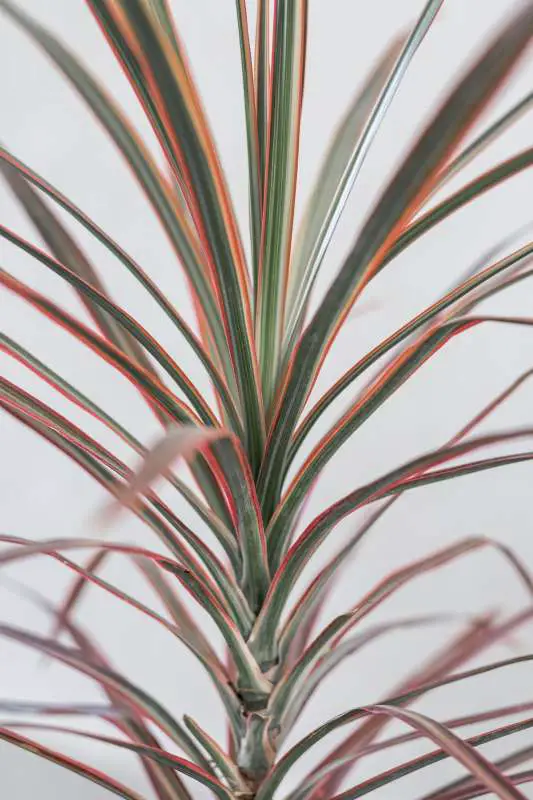
Dragon Tree plant, photo by Alex Quezada, Unsplash
Humidity Needs
Dracaena marginata houseplant doesn’t care a lot about humidity as long as it receives enough light and is watered correctly. Average humidity levels of 25% to 49% are considered favorable, although dracaena will be just fine even in low humidity, it adapts well to low humidity levels.
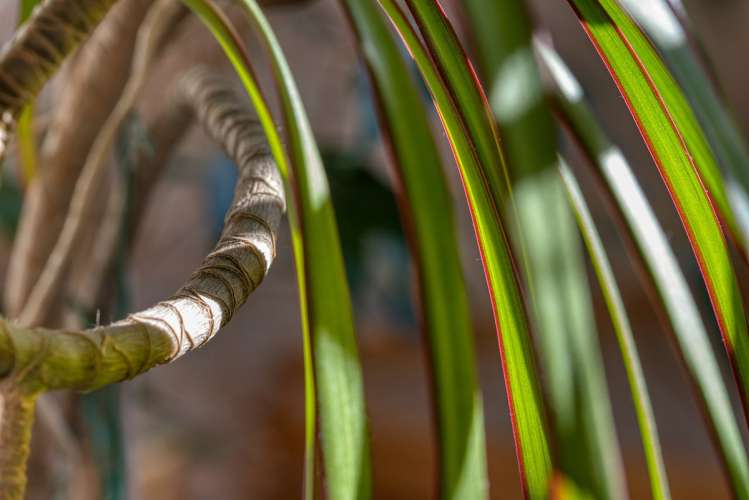
Dracaena plant photo by Gabriele Lässer, Pixabay
Temperature Requirements
Your Dragon Tree will enjoy average daily temperatures of between 65°F (18°) and 75°F (24°C).
Fertilizing
Like most houseplants, Dragon Tree doesn’t need to be fertilized. Most potting mixes are full of nutrients and contain a lot of synthetic fertilizer, so there is really no need to add more fertilizer.
If you repot your Dragon Tree once a year, you will replace the old soil with new soil and provide it with enough nutrients. But if you wish, you can fertilize. Just make sure to do it only if the plant is actively growing and follow the instructions on the label. I recommend the Sill fertilizer as it contains the perfect N-P-K ratio of 9-3-6.
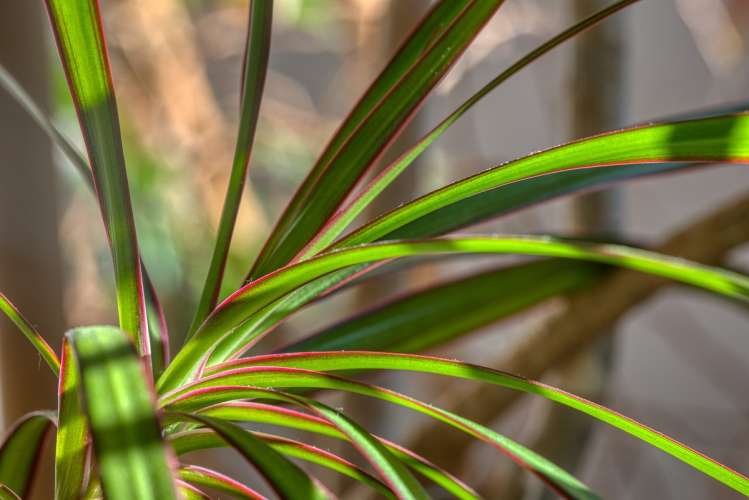
Dracaena Dragon Tree photo by Gabriele Lässer, Pixabay
Soil
If you plan on keeping the houseplant in a lower light area, use a porous mix that doesn’t retain too much water. Most potting mixes will need to be amended because they contain mostly small, fine particles, so they retain a lot of water and fail to provide enough oxygen for the roots. Lack of oxygen leads to roots suffocating and dying of rot. Amend the potting mix using 1 part perlite, 1 part bark, and 3 parts potting soil.
If you plan on keeping your drafon tree in front of a window with bright light, then you can use any tropical mix (like Proven Winners Potting Soil or Mother Earth Groundswell Soil), but it’s still suggested to amend it with perlite or bark.
Repotting
I recommend repotting your Dragon Tree annually to replenish it with fresh nutrients and replace the compacted soil but you don’t need to move it to a larger pot necessarily. Dracaena is one of the slow growers, so the larger pot may be needed every second or maybe even every third year. This will, among other factors, mostly depend on the amount of light your plant is getting. More light equals more photosynthesis equals faster growth.
If you need detailed instructions on how to repot your houseplant properly, get them here.
Toxicity To Humans
Dragon Tree is a non-toxic plant to humans according to the California Poison Control System (CPCS) and the University of California. However, California Poison Control System (CPCS) states that even plants classified as non-toxic can cause vomiting in humans and animals.
Toxicity To Pets
According to the American Society For The Prevention Of Cruelty To Animals (ASPCA), Dragon Tree is toxic to pets. Common symptoms are vomiting (sometimes with blood), hypersalivation, depression, dilated pupils (cats), and anorexia.
Pruning
To prune your Dragon Tree, you will need a pair of scissors or pruning shears. Make sure that the tool is clean and sterile to avoid infection and sharp enough to make the process easier. If you want to remove a whole branch or stalk, simply cut it off at a 45-degree angle. If the plant is too tall, prune it as low as you like. Dead or yellowing leaves will fall off on their own or you can just pull them off with your fingers.
Propagation
You can propagate your Dragon Tree in soil or water, it doesn’t make a lot of difference. You should do what you are more comfortable with. Try one approach, then the other, and see what works for you.
You can see how I did it below.
Here’s how to propagate Dracaena marginata in water.
- Cut off any of the branches.
- Remove some of the lower leaves, so there are empty nodes that can grow roots.
- Put the cutting in water.
- Place next to a window, in bright indirect light.
- Replace water weekly.
- Once the roots get 1 to 2 inches long, you can pot in soil.
You can also cut off a whole cane and propagate it, but then you would get only one plant. By cutting off branches from a single cane, you can get multiple plants from one plant.
It took my Dragon Tree about 1,5 to 2 months to start showing roots in water, but the propagation speed will depend on many factors – the amount of light, water temperature, amount of oxygen it contains, etc.
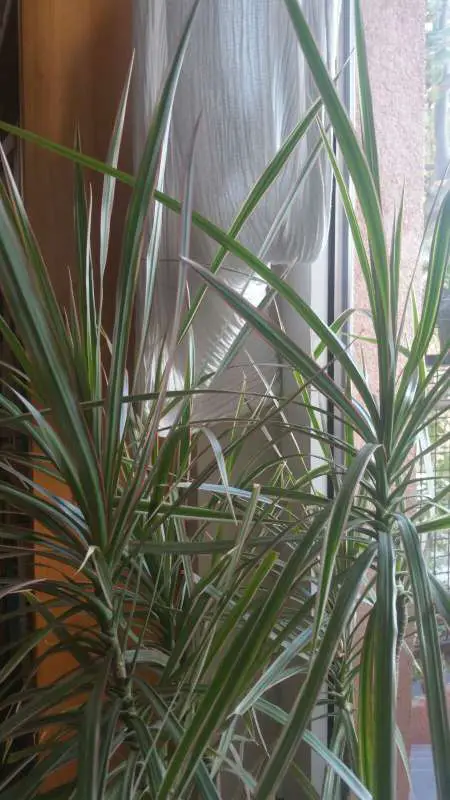
My friend’s Dracaena Marginata
Pests
Pests that can attacking the Dragon Tree plant are spider mites, scales and fungus gnats. To eliminate scales or spider mites you can use neem oil or horticultural oil. You can also use a systemic insecticide on severely infested plants.
To treat the plant with neem oil mix 1-2 tbs of neem oil with 1 gallon of water. Since oil doesn’t mix with water, add one tablespoon of liquid soap which will act as an emulsifier and help with the mixing. Put the mixture in a spray bottle and spray the entire plant, making sure not to miss any part, since pests like to hide in nooks and crannies. You will most likely have to repeat the process a couple of times, every couple of days, to get rid of the pests for good.
To treat the plant with horticultural oil spray the plant according to the instructions on the packaging. Make sure to cover topside and underside of all leaves. If the pests are still present after a few days, reapply.
You can use systemic insecticides if the plant is severely infested or if the other methods don’t work. Mix 1 teaspoon of insecticide per 1/2 gallon of water. Stir water until it dissolves and water your plant thoroughly. The plant will absorb the systemic insecticide through its roots. If the pests are still there after a week or two, repeat treatment. Always follow the instructions on the packaging to avoid causing damage to your plant or the environment.
Diseases
Dragon Tree Plant is prone to Fusarium leaf spot (Fusarium moniliforme) and soft rot (Erwinia carotovora) diseases. Fusarium leaf spot is caused by a fungus and the symptoms of the disease include irregularly shaped tan lesions, sometimes with yellow borders. The best way to prevent this disease is to keep the leaves dry. Once the symptoms manifest, there isnt much you can do, since fungicidal treatment isn’t so efficient. You will need to discard the sick plant.
Symptoms of bacterial soft rot include mushy and rotten areas at the base of the stem, collapse, and discoloration of lower leaves. To prevent soft rot, avoid crowding plants and overhead watering, and discard severely infested plants to prevent further spreading, since there is little hope for recovery.
Common Problems
Brown Leaf Tips
Brown leaf tips on Dragon Tree can occur due to several possible reasons: underwatering, compacted soil, or low humidity. Brown leaf tips are an aesthetic issue, and you shouldn’t worry about them, but if they bother you, you can cut the tips off. To prevent brown tips, address each of the potential causes of the problem. Water your plant once the soil is fully dry. Repot it once a year to provide it with fresh, loose (non-compacted), and nutrient-rich soil. If you have low humidity (below 30%), place a humidifier close to your plant to increase the humidity in the micro area around your plant.
Bottom Leaves Turning Yellow
If the bottom leaves of your Dragon Tree turn yellow, it can be a result of a normal process known as leaf senescence. This is a natural life cycle of leaves when the old leaves turn yellow, then brown, and subsequently die, in order to be replaced with new leaves. They can also turn yellow due to overwatering. In this case, don’t water the plant until the soil is fully dry.
Brown Spots On Leaves
Brown spots on Dragon Tree’s leaves can be caused by scale infestation. Scales can be easily identified as they are circular in shape and appear as shell-like bumps on plant stems. The best treatment is to manually scrape off all scales and then treat the plant with neem oil, or insecticidal soap. For severe infestations, you can use a systemic insecticide.
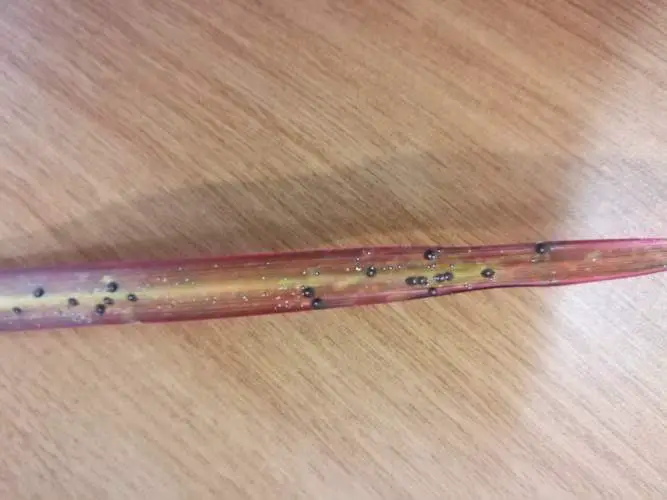
Scale pests on Dracaena Marginata leaf
Yellowing Of The Tips Or Margins Of The Leaf
Yellowing of the tips or margins of the leaf usually indicates fluoride toxicity. Dracaenas are very sensitive to fluoride. To prevent damage from excess fluoride, aim to keep the soil pH between 6.0 and 6.5. Avoid using fertilizers that contain superphosphate because they often have high levels of fluoride. You can also use distilled water for watering, to minimize the fluoride content.
FAQs about Dragon Tree
Are Dragon Trees easy to care for?
Yes, they are very easy to care for and excellent plants for newcomers into the houseplant world. A Dragon Tree will love all the light it can get in your home but will also tolerate low-light areas if necessary, and also doesn’t require frequent watering. If you’re a frequent traveler, this is an excellent plant to have.
How fast does a Dragon Tree grow?
Dracaena Dragon Tree is not a fast growing plant. If you would like a bigger specimen, I suggest buying a bigger one right away, instead of getting a small plant and waiting for it for years to increase in size.
What’s the difference between Dracaena Marginata and Dracaena Draco?
Dracaena draco is a plant that is completely different from Dracaena marginata, as you can see in the photo of Dracaena draco below. I found at least one very popular blog mistakenly describing Dracaena marginata as Dracaena draco, which is probably one of the reasons why there is some confusion as to the difference between these two clearly very different species.
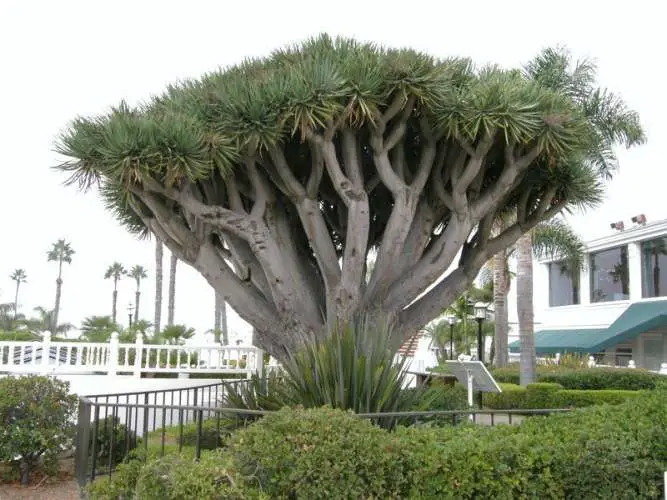
Dracaena Draco photo from Dave’s Garden website
Leaves are turning yellow on my Dragon Tree, why?
This is one of the questions about the Dragon Tree houseplant I get pretty often.
As the plant grows it will naturally lose the lowest leaves, so don’t be concerned about this. Most of the cane will be bare, with leaves on top of each stalk. As the new leaves emerge from the top of the plant, the bottom leaves will turn yellow and the plant will take mobile nutrients from them. They will turn yellow, they will dry out, and fall off. And it’s okay. :)
Also, if you notice a few small brown leaf tips, know that they are usually not something to worry about, as they can show up for many reasons, but are only an aesthetic issue.
When caring for dragon tree plants and houseplants in general, one of the most important lessons you should learn as soon as possible is that you should not expect perfection from your indoor plants. They are living beings and they go through seasons and stages. Leaves on your houseplants have a limited lifespan and if they turn yellow and fall off, that’s usually just a part of your plant’s lifecycle. The leaves will eventually die even if you make sure to give your plant the best care possible, as you should. So, as long as your Dragon tree keeps putting up new growth, you shouldn’t worry about some leaves turning yellow.
Have More Questions about Dracaena Marginata Care?
If you’re having any doubts or more questions regarding Dragon tree care, please let me know in the comments below. You can also schedule a virtual one-on-one consultation with me and get the help you need.
Always happy to help!
Yours Truly,

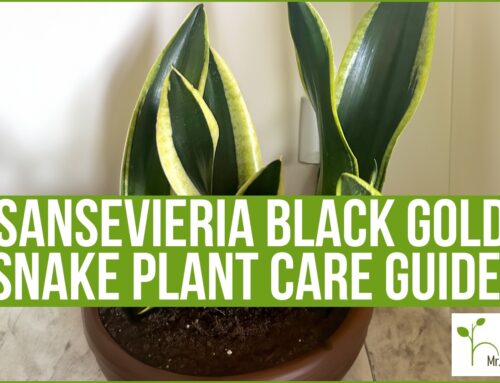

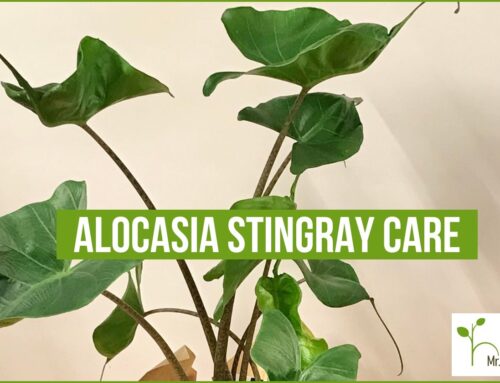


My Dragon Tree is a couple years old. All of a sudden, when I was checking all my plants last week, I noticed yellow spots on it’s leaves. Thought too much bright light or too much heat. It’s near a sliding glass door. So. I moved it farther away. What did I do wrong?
Hi MaryAnn, diagnosing a plant is a bit more complicated and generally requires some photos and more information in order to determine what exactly happened. The reason for this is that one symptom can have different causes. For example, yellow spots could be caused by pests or by fluoride on different dracaena species, in some cases by too much light or by other reasons. I would be reluctant to move the plant away from the window unless you determine with 100% certainty that too much direct sun is the cause. If the plant is not getting a lot of direct sun, don’t move it away from the window.
My Dragon Tree has yellow spots on the uppermost part of the plant. What’s going on with it?
Hi MarryAnn, I’m afraid it’s hard to diagnose a plant without a photo. Can you send me a photo on Instagram?
My Dracaena Marginata has been under my care for about a year and a half. It’s quite small, but overall appears to be doing fine. However, I have noticed that its leaves have started to fall more in the shape of a weeping willing vs the way they looked when I bought it. The best way I can describe their original look is kind of like a spikey hairdo. The newer, top leaves still kind of stick up, but the lower leaves do not. Is it unhappy where it’s located, maybe, or is this normal? For perspective, the main trunk is 3 inches tall, and each of its three branches are 2 inches tall, while the longest leaves are 9 inches long.
Hi Cherie, it would be much easier if I could see a photo :) The top leaves should stand up and the lower leaves should fall downwards, that is generally normal. But the bottom leaves can get too droopy sometimes and it usually happens if the plant needs water. I would need to see a photo though to say for sure. Can you DM me on Instagram?